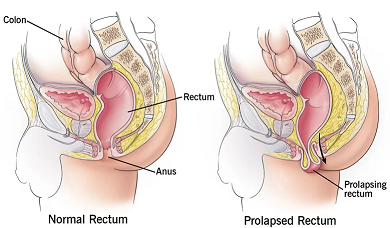
Rectal Prolapse
Rectal prolapse occurs when your rectum, part of your large intestine, slips down inside your anus. It’s caused by a weakening of the muscles that hold it in place. The word ‘prolapse’ is used when any organ of the body slips from its original position. Rectal prolapse may resemble or feel like hemorrhoids, but it does not resolve on its own. You'll need surgery to fix it eventually.
Symptoms of Rectal Prolapse
If you have rectal prolapse, you may notice a reddish mass coming out of the anus, especially if you strain during a bowel movement. The mass may slip back inside the anus, or it may remain visible.
Other signs and symptoms may include:
- The inability to control bowel movements (fecal incontinence)
- Constipation or diarrhea
- Leaking blood or mucus from the rectum
- After a bowel movement, you have the sensation that your rectum is not empty. Tests and Treatment
The complete diagnostic procedure for rectal prolapse includes:
- Digital Rectal Exam.
- Defecography.
- Anorectal Manometry.
- Lower GI Series (barium enema).
- Colonoscopy.
- Electromyography (EMG)
There are a number of surgical options for treating rectal prolapse. The specifics of your condition and the surgeon will determine which surgical procedure is best for you. The most common surgeries for rectal prolapse are as follows:
- Rectopexy or Rectal Prolapse Surgery Through the Abdomen
- Laparoscopic rectal prolapse surgery
- Robotic surgery
- Perineal Rectosigmoidectomy
- Delorme Procedure
Make an appointment right away for consultation on your proctological issue.
Call With Doctor